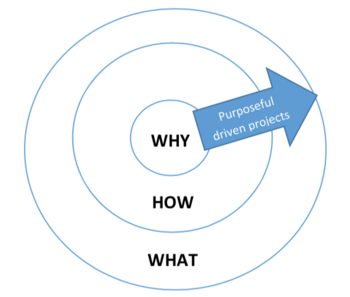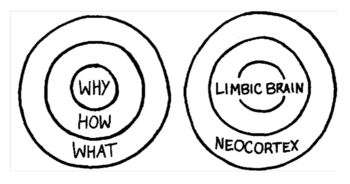Why, How, What (The Golden Circle Model)
Contents |
Abstract

One of the key things for a project manager, in regards to doing projects, is to establish a strong vision. By establishing the purpose of the project, the vision enables the team members of the projects to collaborate, it gives them a direction and it gives the team members a great opportunity to develop and grow. By having a purpose of a project, it becomes possible to answer why the project is being done in the first place. [1]
According to Best Management Practice, a vision is "a picture of a better future". [2] There are several ways to establish a vision of a project and one of them is by asking: WHY? Simon Sinek, a British author and marketing consultant is the person who has developed The Golden Circle Model. This model consists of the questions WHY, HOW and WHAT. According to Sinek, every organization knows WHAT they are doing, some know HOW they do it and very few know WHY they are doing it. And by WHY (according to Sinek) very few organizations know the purpose of the things they are doing. As a result Sinek finds that the way unsuccessful organizations and leaders think is from outside in (from WHAT to WHY). In contrast, the more inspiring and successful organizations and leaders think from inside out (from WHY to WHAT). [1] [3]
In the following of this article, several aspects of the model will be treated such as
- A more detailed explanation of the model.
- How the model can be applied in regards to project management.
- The limitations of the model.
Big Idea
In this section of the article the Golden Circle Model will be explained and the points that the model itself states will also be included in this section.
The Golden Circle model is a model that can be used in a variety of ways. It can be used by organizations, by people everyday and by project managers among others. The model is designed by Simon Sinek and it consists of 3 parts: WHY, HOW and WHAT.
The WHAT part of the model describes - as the name states - WHAT is being done in the project. HOW describes HOW the WHAT part of the project is conducted. However, the WHY part of the model is the purpose of the project. It states WHY the WHAT part of the project is being done.
According to Sinek, everyone knows WHAT they are doing, some people know HOW they do it but very few people know WHY they do it. The question "WHY?" shall not be answered with something as making money, since that is a result. However by asking WHY, the purpose of the project and its cause and belief shall be defined.[4]
The Golden Circle Model states that the way most people are thinking is from WHAT to WHY, which corresponds to from outside in, since it is easier to go from things that are most clear (WHAT) to things that are most difficult to understand and thus the fuzziest things (WHY). In contrast to those people, inspired leaders including project managers and other inspired people think from WHY to WHAT - from inside out and they are the ones who will drive projects purposefully. The inspired leaders who know WHY they do the projects will not only be successfu,l but they will be able to sustain the success and be able to grow continuously. On the other hand, the leaders who begin to lose the idea of WHY the projects are done - the purpose and belief of the project, those are the ones who will experience lack of loyalty and inspiration among the co-workers. When the loyalty and inspiration among the co-workers are lost, the project manager will (according to the model) most likely make use of manipulation rather than inspiration to motivate behavior.[4]

The Golden Circle Model is not just a model that help leaders and project managers to communicate to successfully drive a project. The model is closely related to the human biology and especially the human brain. The WHAT part of the model that a leader uses corresponds with the neocortex, a part of the brain that is responsible for analytical thought among others. However both HOW and especially WHY corresponds with the limbic brain which is responsible for feelings such as loyalty. When leaders communicate from outside in, the leaders are able to connect with their co-workers in terms of information. The downside of this way of communicating a vision is that it will not drive behavior. On the other hand, when leaders communicate the vision from inside out, it triggers the part of the human brain that is responsible for decision making and it will thus drive the behavior of the participants of the project.[4]
Clarity, Discipline and Consistency
In his model, Sinek explains something he calls the Clarity of WHY, the Discipline of HOW and the Consistency of WHAT. He believes that everything starts with clarity, meaning that the inspiring leader and project manager need to know WHY they do WHAT. They also need to clearly articulate the WHY to their co-workers since the co-workers need to know WHY they have to be part of a project and passionately working for the project.
With the discipline of HOW, Sinek believes that the HOWs are the values and principles that will help project managers and the team members to successfully bring the purpose of the project to life. The discipline of HOW is important when things seem to go wrong. When a project manager is able to hold his or her team members accountable to the values and principles, it will inspire and enhance team members to team work and work more passionately.
As stated earlier WHY is the purpose and belief of the project and HOWs are the actions. The WHATs however are the results of the HOWs. Since team members buy WHY they do things rather than WHAT they do, it is - according to the model - important that the WHATs are consistent. When the WHATs are consistent, the people that a leader inspires will most likely believe the purpose of the project, the WHY. With consistency of WHAT comes authenticity. Authenticity basically means that the Golden Circle is in balance, meaning that both the project manager and the team members believe the things that are said and done. When the Golden Circle is not in balance however, then stress and uncertainty take place. Sinek does not believe that authenticity is an absolute must in terms of having success, but it will definitely help. However, without a clear definition of the WHY of a project, the project itself cannot have an authenticity.[4]
Example 1
In the late nineteenth century the new technology was creating an airplane. The most well-known people in this regard are Samuel Pierpont Langley and the Wright brothers. The Wright brothers are the ones who are actually credited for inventing the world's first successful airplane in 1903. Langley graduated from high school and worked as a professor of mathematics at an university. Langley was a well connected man and he was well funded. He was able to assemble a great team around him to create the world's first successful airplane. The team members included well-known engineers and the team had access to good resources in terms of materials. On the other hand the Wright brothers did attend high school for three years but they did not get their diploma. Their team included people who did not graduate college and even people who did not graduate high school. Unlike Langley they were not well funded. The only source of money they had access to was the money they made during the time they worked at their bicycle shop. [5] [6]
When a overview is taken of the situations, Samuel Pierpont Langley was the person who had the best chances of having success. However, the Wright brothers were the first ones to succeed in 1903. According to Sinek, one advantage that the Wright brothers had over Langley was that they had inspiration and they were able to inspire others. The Wright brothers were inspired and motivated by a belief and a purpose - or in other words, they started with a WHY - where they also inspired their team members. In contrast, Langley started and was motivated by WHAT. He was more concerned with becoming famous and wealthy. Because the Wright brothers started with WHY and because they were thinking from inside out, they were the ones who succeeded. [4]
Example 2
Applications
Limitations
Annotated bibliography
References
- ↑ 1.0 1.1 1.2 Geraldi, Joana et al., How to DO Projects Vision, Version 0.5. BETA VERSION, 2016.
- ↑ Best Management Practice, Managing Succesful Programmes, 2011 Edition.
- ↑ Simon Sinek: How great leaders inspire action, Accessed 12 February 2018.
- ↑ 4.0 4.1 4.2 4.3 4.4 4.5 Sinek, Simon, Start With Why: How Great Leaders Inspire Everyone to Take Action, 2009, Portfolio. ISBN 978-1-59184-280-4.
- ↑ Wright brothers, https://en.wikipedia.org/wiki/Wright_brothers, Accessed 16 February 2018.
- ↑ Samuel Pierpont Langley, https://en.wikipedia.org/wiki/Samuel_Pierpont_Langley, Accessed 16 February 2018.